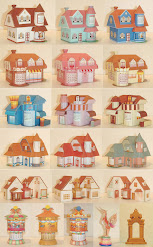The Best Toys
What kind of toy should I get for my child? How much money I spend? If you are a parent, probably you have asked these questions many times. Well, the good news is that the best toys may be the ones that are the least expensive.
"Kids benefit more from active manipulation and exploration than from passive watch- ing, so simple toys that demand imagination are better than flashy battery-powered cars or talking dolls, which limit what your child can do," says the book Motivated Minds- Rais- ing Children to Love Learning. The latter toys may be fun at first, but children usually lose interest in them quickly because they don't allow them to experiment, explore, or create.
Depending on a child's age, mentally stimulating toys include things as simple as build- ing blocks, empty boxes, paper, art materials, and even sand and water. "Small toys, like farm animals," says Motivated Minds, "will give [a child] a chance to match, group, and com- pare, and to develop his language skills by making up stories." The book also suggests sim- ple musical instruments-if you are prepared to endure the noise-because these allow child- ren to explore sounds and their patterns.
Children have imaginations, and they are eager both to learn and play. So why not help them In all three areas by choosing their toys wisely.
Tips: Families that make a success of learning. 1-Frequent communication of high but reasonable expectations to children, given in love. 2-Aview of hard work as a key to success. 3-An active life-style, not a sedentary one. 4-Many hours of home-centered learning each week and activities that include school homework,
reading for leisure, hobbies, family projects, and household training and duties. 5-A view of the family as a mutual-support system and problem-solving unit. 6-Clearly understood household rules, consistently enforced. 7-Frequent contact with teachers. 8- An emphasis on spiritual growth.
http://www.tpot4t.com/
What kind of toy should I get for my child? How much money I spend? If you are a parent, probably you have asked these questions many times. Well, the good news is that the best toys may be the ones that are the least expensive.
"Kids benefit more from active manipulation and exploration than from passive watch- ing, so simple toys that demand imagination are better than flashy battery-powered cars or talking dolls, which limit what your child can do," says the book Motivated Minds- Rais- ing Children to Love Learning. The latter toys may be fun at first, but children usually lose interest in them quickly because they don't allow them to experiment, explore, or create.
Depending on a child's age, mentally stimulating toys include things as simple as build- ing blocks, empty boxes, paper, art materials, and even sand and water. "Small toys, like farm animals," says Motivated Minds, "will give [a child] a chance to match, group, and com- pare, and to develop his language skills by making up stories." The book also suggests sim- ple musical instruments-if you are prepared to endure the noise-because these allow child- ren to explore sounds and their patterns.
Children have imaginations, and they are eager both to learn and play. So why not help them In all three areas by choosing their toys wisely.
Tips: Families that make a success of learning. 1-Frequent communication of high but reasonable expectations to children, given in love. 2-Aview of hard work as a key to success. 3-An active life-style, not a sedentary one. 4-Many hours of home-centered learning each week and activities that include school homework,
reading for leisure, hobbies, family projects, and household training and duties. 5-A view of the family as a mutual-support system and problem-solving unit. 6-Clearly understood household rules, consistently enforced. 7-Frequent contact with teachers. 8- An emphasis on spiritual growth.
http://www.tpot4t.com/
About the Author
Retired great grandmom.

